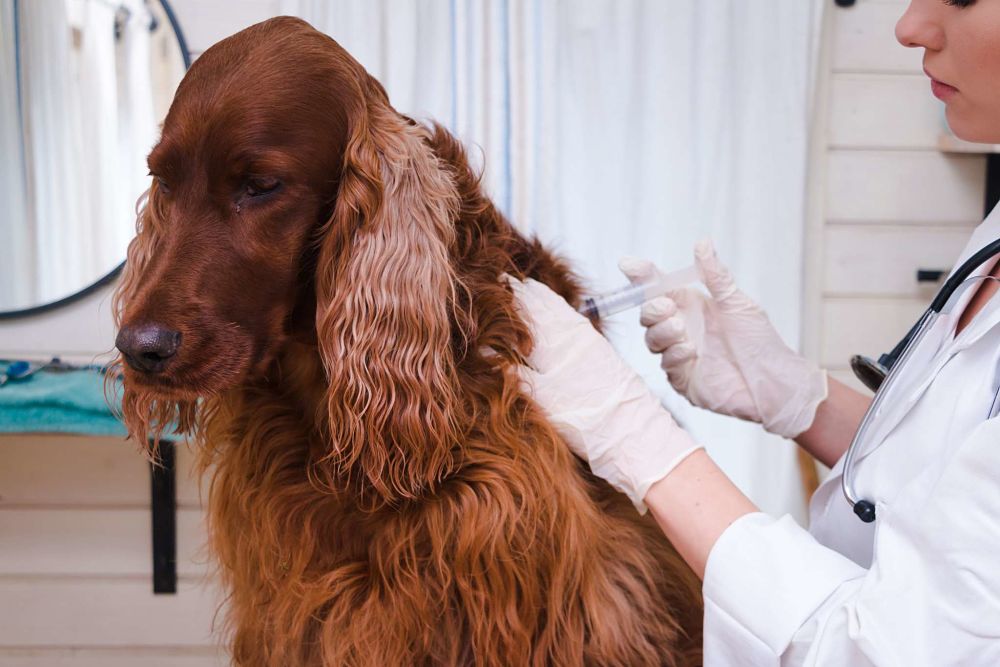
8 Ways to Tell If Your Dog Is Sick
by Amy Smith - 6/6/19
It can take a bit of detective work to determine if your dog is sick or running a fever. Dogs instinctively hide their discomfort. You may not notice symptoms at first, as your dog might be avoiding you if he feels unwell. Also, of course, your dog can’t just tell you what’s troubling him. You don’t want your furry friend to suffer for long, so watch for these clues that he is feeling under the weather.

1. Prolonged vomiting and diarrhea
t’s pretty common for dogs to vomit from time to time — after eating too much, for example, or eating something that disagrees with them, such as table scraps or garbage. Stomach upset can also cause diarrhea. Try withholding food and water for 12 hours, then offer just water. If your dog keeps that down, offer a little food and continue to monitor his reaction. If the vomiting and diarrhea persist more than 24 hours or if there is blood in your dog’s vomit or stool, it’s time for a visit to the vet.

2. Difficulty urinating
If you notice a difference in your dog’s “bathroom” habits, pay close attention. A dog that is straining, experiencing interrupted urination, or apparently in pain could have a serious condition, such as a urinary tract infection, kidney stones or even cancer. Problems with urination warrant a call to your vet.

3. Bloated abdomen
Another potentially serious symptom is a swollen abdomen, especially if it is accompanied by dry heaves and agitation. This could mean your dog has “bloat,” a condition in which the stomach expands with excessive gas. Bloat can put pressure on major blood vessels and even cause the stomach and intestines to become twisted, a condition that without immediate medical attention can be fatal.

4. Coughing
Coughing is a common symptom that may be caused by a simple viral or bacterial infection. Coughing can also signal that a foreign object is lodged in the dog’s throat. More rarely, coughing is associated with certain heart conditions. If your dog’s cough does not dislodge a foreign object, persists for more than a few days or is accompanied by heavy breathing, your dog may need to see the vet for antibiotics. Try using a humidifier at home to help ease the cough.

5. Lethargy and loss of appetite
Your dog’s breed, size, age and personality help determine his usual level of energy and his appetite. You’re the one who really knows what’s normal and what’s not when it comes to his playing and eating. If he seems more lethargic than usual, is not interested in his usual games and eats much less than usual or refuses to eat at all, he may need a vet’s care.

6. Limping and difficulty going up stairs
Unusual gait, such as limping and problems climbing stairs, can mean a variety of problems for your dog. If the limping begins suddenly, your dog may have a sprained joint, something embedded in a paw pad or even a broken bone. Limping that develops more gradually could be a sign of an underlying joint issues, such as arthritis or tick-borne Lyme disease, which can cause inflamed joints.

7. Unusual odor from mouth or ears
If you notice an unusually foul odor from your dog’s mouth or ears, there may be an underlying health problem. Common causes for mouth odor are dental problems, including gum disease, and indigestion. Smelly ears can be caused by ear infections, so get your dog checked for ear mites and bacteria in the ear canal.

8. Fever
A dog’s normal body temperature runs between 99.5 and 102.5 degrees Fahrenheit. Infection, bacterial or viral diseases and ingesting poisonous substances each can cause a dog to run a fever. You may suspect fever if your dog is lethargic, has a hot dry nose and ears, shivers or loses appetite. But the only way to know for certain is to take the dog’s temperature. This can be done rectally with a digital thermometer or you may use a dog-specific ear thermometer. If you get a reading over 103 degrees, take your dog to the vet right away. He’s sick!
Amy Smith is a writer, specializing in family and parenting topics. She teaches English, Latin, and music at a private school and lives with her husband and five children on a small homestead in rural Pennsylvania.
References
- https://www.akc.org/expert-advice/health/dog-fever-and-temperature/
- http://www.vetstreet.com/our-pet-experts/7-warning-signs-your-dog-might-be-sick
- https://www.doghealth.com/care/how-to/1923-how-to-tell-if-your-dog-is-sick
- https://www.whole-dog-journal.com/issues/8_1/features/Dog-BloatCausesSignsandSymptoms_15682-1.html
- https://www.akc.org/expert-advice/health/dog-having-trouble-urinating-2/
- http://www.vetstreet.com/dr-marty-becker/why-is-my-dog-coughing
- https://www.akc.org/expert-advice/health/why-is-my-dog-limping/
- https://www.dogzhealth.com/dog-stink/
- https://www.akc.org/expert-advice/health/dog-fever-and-temperature/




.jpg)

.jpg)
























.jpg)
























































.jpg)













